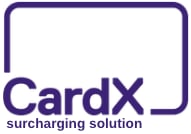Credit Card Surcharges and How Your Business Can Apply Them
Surcharges can offset the expense of credit card processing fees, but there are limitations and legal guidelines.

Many, or all, of the products featured on this page are from our advertising partners who compensate us when you take certain actions on our website or click to take an action on their website. However, this does not influence our evaluations. Our opinions are our own. Here is a list of our partners and here's how we make money.
Adding a credit card surcharge to the sales price of card transactions may seem like a good solution for counteracting the rising cost of credit card processing fees. However, a business needs to follow specific rules when applying credit card surcharges. You should also consider customer acceptance, card network resistance and competitor practices before moving forward with a credit card surcharge program for your business.
CardXShop Now on CardX's website |
What is a credit card surcharge?
A credit card surcharge is a fee paid by a customer who chooses to use a credit card to purchase a good or service. A business adds this extra charge to the advertised price to help cover the cost of credit card processing fees. Surcharges are legal in most states, but a handful of states prohibit the use of surcharges. According to Visa, as of spring 2023, these states include:
Connecticut.
Maine.
Massachusetts.
Oklahoma.
There is also ongoing litigation in some states that affects surcharge rules. For example, Colorado passed a law to allow surcharges, which took effect in July 2022. But the law limits the surcharge amount to a maximum of 2%, which is lower than the maximum surcharge cap set by the credit card networks. Before moving forward with a surcharge program for your business, be sure to review the laws of your state.
In addition to state laws, business owners must also follow specific rules for credit card surcharging.
advertisement

Helcim POS
0.40% + 8¢
plus interchange, in-person; 0.50% + 25¢ plus interchange, online.
on Helcim's website
What rules apply to credit card surcharges?
A business’s ability to add a surcharge to credit card purchases and the rules that govern the practice are primarily the result of a 2013 court settlement between a number of merchants and Visa and Mastercard. Each network sets its own requirements for imposing credit card surcharges, but Visa and Mastercard, in particular, share many rules in common:
Merchants must give 30 days' written notice to the card network and payment processor before initiating surcharges.
A surcharge can’t be applied to purchases made with debit or prepaid cards.
The surcharge fee can’t be more than the cost of processing the credit card and is capped at 3% of the purchase price for Visa cards and 4% for Mastercard.
Notice of the surcharge must be given at the entrance of the business and at the point of sale. For online transactions, the surcharge notice must appear on the business’s website where the card brand is mentioned.
The surcharge dollar amount must appear on the receipt.
Other card networks such as American Express and Discover may have additional requirements.
A business can apply the credit card surcharge in one of two ways:
Brand-level surcharge. The same surcharge percentage is applied to all cards under a brand. For example, the surcharge for all Visa cards would be the same percentage. The percentage can’t be more than the average processing cost paid by the merchant and is capped at 3% for Visa and 4% for Mastercard.
Product-level surcharge. The surcharge percentage varies based on the type of card. For example, a higher surcharge percentage is applied to rewards cards because they typically have higher processing fees. The surcharge fee can’t be more than the specific processing cost paid by the merchant for that type of card and is capped at 3% for Visa and 4% for Mastercard.
What should a merchant consider before adding a surcharge?
On the surface, adding a surcharge to credit card purchases may seem like an easy way to cut costs. It’s true that the additional revenue generated by credit card surcharges can defray the expense of payment processing at the transaction level. However, before you make a decision for your business, there are other considerations to take into account.
Card network opposition
Although the 2013 settlement allows merchants to legally assess surcharges for credit card use in most states, the card networks strongly discourage it. Visa views surcharging as a practice that penalizes cardholders and even quietly sends out auditors to identify merchants who are surcharging in a noncompliant manner. Those merchants are subject to a hefty fine.
It’s important to note the nuance here: Card networks, of course, have a stake in whether a business accepts credit card payments. After all, it’s the card networks that set the interchange fees a merchant pays for each card transaction. And the banks that issue those cards also take a chunk of those fees. When interchange fees increase (in addition to payment processor fees), merchants see that in their bottom line — higher fees paid out per transaction equates to less revenue.
Customer acceptance
Although the card networks often raise concerns about customer satisfaction and loyalty, customer acceptance is likely to vary based on an individual business’s relationship with its customers. If given a choice, most cardholders would likely want to avoid any additional cost to a purchase. However, that doesn't mean that cardholders would not accept a surcharge, especially if they are notified in advance, as required by law, and given the business reason for the charge.
Competitor practices
Another factor to consider is whether your competitors have surcharge programs. It can help if you aren’t the only one charging your customers for credit card use. Customer acceptance tends to increase when something becomes common practice. Also, surcharge fees may be more prevalent in certain industries, such as construction and medical services.
Alternatives to credit card surcharges
While surcharging credit card purchases can offset the cost of processing transactions, there are alternatives that your customers may find more acceptable:
Minimum purchase requirement. A business can set a minimum transaction amount for credit card users. The minimum can’t exceed $10 and must be the same for all card networks. For example, you can’t set a $5 limit for Visa and a $10 limit for Mastercard.
Cash discount program. A business can offer a discount to customers who pay with cash to reduce the number of card transactions. A cash discount is a reduction in price offered by a business to customers who pay with physical cash instead of cards or digital wallets. The discount is deducted from the advertised price when the customer pays. Cash discounts are legal throughout the U.S.
Convenience fee. This is an additional charge for allowing the customer to use an alternative form of payment. The alternative form of payment is different from what the business normally accepts. For example, a business that normally takes payments in person may charge a convenience fee for allowing a customer to pay over the phone. Convenience fees are legal in all U.S. states.
Finally, if you’re a business owner feeling the weight of payment processing fees, but you're not comfortable imposing credit card surcharges, here are a couple of steps you can take instead:
Build processing costs into pricing. A business can increase the overall pricing of products and services to cover card transaction fees.
Reduce processing rates. Shopping around for competitive rates, asking for volume discounts and negotiating with your payment processor can also result in lower processing fees.
Find the most cost-effective processor for your business
FEATURED



